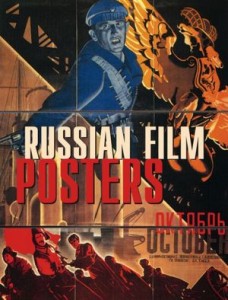Russian Film Posters 1900-1930 with an introduction by Maria-Christina Boerner (Vivays Publishing, April 2012). 200 pages. ISBN: 978-1908126153 (hardback). Price £19.95
 About the reviewer: Birgit Beumers is Professor in Film Studies at Aberystwyth University. She specialises in contemporary Russian culture and her publications include: a monograph on Yuri Lyubimov at the Taganka Theatre; the filmmaker Nikita Mikhalkov and a companion on his Oscar-winning film Burnt by the Sun; Pop Culture Russia! (2005), Russia on Reels: The Russian Idea in Post-Soviet Cinema (1999), 24 Frames: The Cinema of Russia and the former Soviet Union (2007) and A History of Russian Cinema (2009). She is currently researching animation, trick films and technical innovation in Soviet cinema of the first half of the 20th century.
About the reviewer: Birgit Beumers is Professor in Film Studies at Aberystwyth University. She specialises in contemporary Russian culture and her publications include: a monograph on Yuri Lyubimov at the Taganka Theatre; the filmmaker Nikita Mikhalkov and a companion on his Oscar-winning film Burnt by the Sun; Pop Culture Russia! (2005), Russia on Reels: The Russian Idea in Post-Soviet Cinema (1999), 24 Frames: The Cinema of Russia and the former Soviet Union (2007) and A History of Russian Cinema (2009). She is currently researching animation, trick films and technical innovation in Soviet cinema of the first half of the 20th century.
This volume is an enormously valuable addition to the teaching of Russian and Soviet cinema ...
This volume is an enormously valuable addition to the teaching of Russian and Soviet cinema, even if there are several reservations this reviewer has about the edition. Above all, it is a competitively priced volume with 160 good-quality reproductions of Russian film posters, some from archival sources and therefore not widely available. The brief introduction (all text comes in four languages: English, Spanish, German and French) is far too sketchy to be meaningful. It references the lubok, graphic art and caricature in relation to poster art without paying any attention to the background of artists (especially relevant for the 1920s, when many were also set designers and production designers) or the filmmakers, their films and style. In order to find the reference to the film featured on a poster, the reader has to flick to the back of the book, which contains one appendix on artists and another on the films featured in the poster section.
 The temporal frame that the volume embraces seems a strange choice: numerous posters are for pre-Revolutionary films and many of those are hitherto unpublished, but many of the films have not survived or were condemned to a shelf life. Not only are most of the pre-Revolutionary posters for obscure films, but their designers are not introduced or contextualised. We get no sense of the period, or the films, by looking at these posters. For the 1920s the selection becomes richer, with variations of posters for the same film. So it is somewhat problematic to compare posters for films about which we know very little to the effect and the vision presented in posters for better-known films. On the other hand, the design issue drives this volume, rather than the cinematic history – which would be an interesting, but maybe a different undertaking. Yet from a design point of view it might have been worth focussing on the avant-garde and its development into Socialist Realism rather than include the pre-Revolutionary era; or, alternatively, to offer a comparison to European poster design at the time. It would also have been worthwhile commenting more on the studios and/or distributors, who – after all – hired the poster designer in the first place; and to say a little bit about the film’s style in relation to the poster art. None of this is claimed in the remit of this volume, which is thus a fabulous tool for the teacher, but less so for the student, who will – without guidance – be lost in a jungle of excellent reproductions. More of a conceptual framework would have helped to make this a first-class tool.
The temporal frame that the volume embraces seems a strange choice: numerous posters are for pre-Revolutionary films and many of those are hitherto unpublished, but many of the films have not survived or were condemned to a shelf life. Not only are most of the pre-Revolutionary posters for obscure films, but their designers are not introduced or contextualised. We get no sense of the period, or the films, by looking at these posters. For the 1920s the selection becomes richer, with variations of posters for the same film. So it is somewhat problematic to compare posters for films about which we know very little to the effect and the vision presented in posters for better-known films. On the other hand, the design issue drives this volume, rather than the cinematic history – which would be an interesting, but maybe a different undertaking. Yet from a design point of view it might have been worth focussing on the avant-garde and its development into Socialist Realism rather than include the pre-Revolutionary era; or, alternatively, to offer a comparison to European poster design at the time. It would also have been worthwhile commenting more on the studios and/or distributors, who – after all – hired the poster designer in the first place; and to say a little bit about the film’s style in relation to the poster art. None of this is claimed in the remit of this volume, which is thus a fabulous tool for the teacher, but less so for the student, who will – without guidance – be lost in a jungle of excellent reproductions. More of a conceptual framework would have helped to make this a first-class tool.
The volume includes posters for documentaries that are intermingled with feature film posters, but were there any posters advertising animated films? The political cartoon was on the rise during the 1920s, and it is through the animated films of Dziga Vertov that the cartoonist Viktor Deni reached the screen: what was the relationship between cartoonist and filmmaker, book illustrator and animator?
Yet maybe there is scope for another volume on this aspect, or indeed on later Soviet poster art.
Professor Birgit Beumers